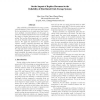Free Online Productivity Tools
i2Speak
i2Symbol
i2OCR
iTex2Img
iWeb2Print
iWeb2Shot
i2Type
iPdf2Split
iPdf2Merge
i2Bopomofo
i2Arabic
i2Style
i2Image
i2PDF
iLatex2Rtf
Sci2ools
ICDCS
2005
IEEE
2005
IEEE
On the Impact of Replica Placement to the Reliability of Distributed Brick Storage Systems
Data reliability of distributed brick storage systems critically depends on the replica placement policy, and the two governing forces are repair speed and sensitivity to multiple concurrent failures. In this paper, we provide an analytical framework to reason and quantify the impact of replica placement policy to system reliability. The novelty of the framework is its consideration of the bounded network bandwidth for data maintenance. We apply the framework to two popular schemes, namely sequential placement and random placement, and show that both have drawbacks that significantly degrade data reliability. We then propose the stripe placement scheme and find the near-optimal configuration parameter such that it provides much better reliability. We further discuss the possibility of addressing the problem of correlated brick failures in our analytical framework.
Analytical Framework | Data Reliability | Distributed And Parallel Computing | ICDCS 2005 | Replica Placement Policy |
| Added | 24 Jun 2010 |
| Updated | 24 Jun 2010 |
| Type | Conference |
| Year | 2005 |
| Where | ICDCS |
| Authors | Qiao Lian, Wei Chen, Zheng Zhang |
Comments (0)

